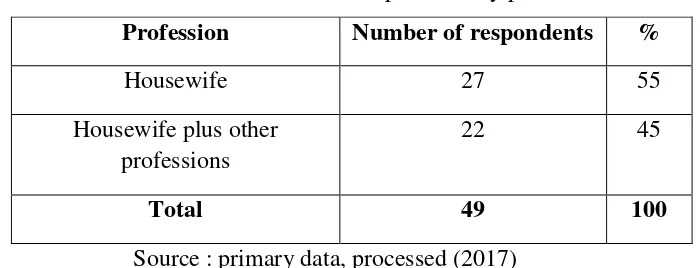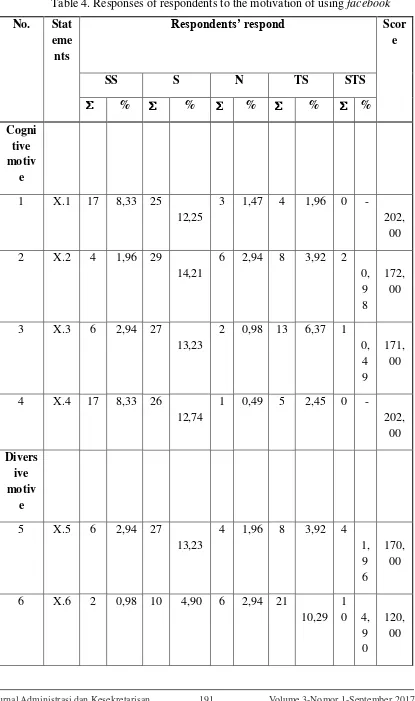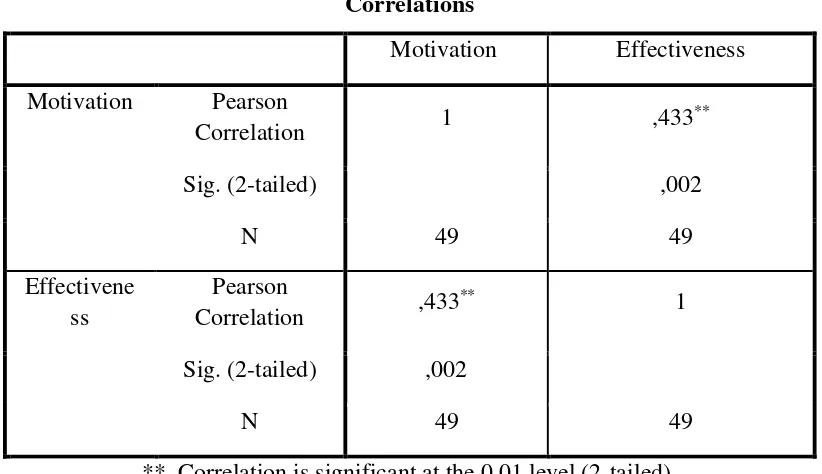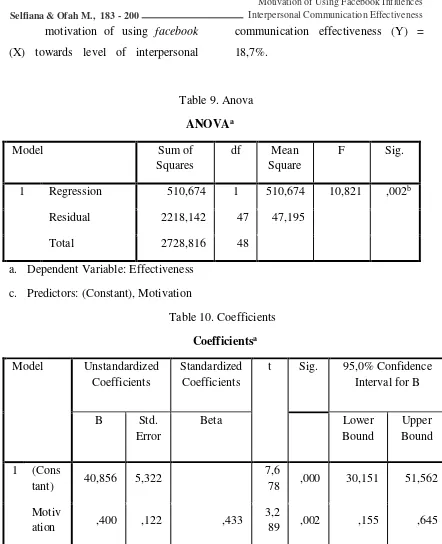ISSN 2598-2451
MOTIVATION OF USING
INFLUENCES INTERPERSONAL
COMMUNICATION EFFECTIVENESS
Selfiana
ASM Bina Insani
E-mail: selfianas@gmail.com
Ofah Munadzdzofah
ASM Bina Insani
E-mail: ofah.munadz@gmail.com
Abstract: Facebook is one of the social media that has been used by many people, ranging from children to adults. Based on the observation, the housewives tend to use facebook to communicate with various motivations. The messages written in the status of facebook influence the interpersonal communication effectiveness in the real world. This research used quantitative method. The result showed that the interpersonal communication effectiveness among housewives is quite influenced by the motivation of using facebook. This is indicated by the correlation coefficient value of 0,433. The result of determination coefficient 18,7% showed that the motivation of using facebook give the influence of 18,7% toward the interpersonal communication effectiveness among housewives in Cluster Ubud, Puri Gading Housing, Bekasi.
Keywords: Facebook, Motivation, Interpersonal Communication, Effectiveness
Abstrak: Facebook merupakan salah satu media sosial yang sudah digunakan oleh banyak orang, mulai dari kalangan anak-anak hingga orang dewasa. Berdasarkan pengamatan, para ibu rumahtangga cenderung menggunakan facebook untuk melakukan komunikasi dengan berbagai motivasi. Pesan yang tertulis di bagian status mempengaruhi efektivitas komunikasi antarpribadi di dunia nyata. Penelitian ini menggunakan metode kuantitatif. Hasil penelitian menunjukkan bahwa efektivitas komunikasi antar pribadi di kalangan ibu rumah tangga cukup dipengaruhi oleh motivasi penggunaan facebook. Hal ini ditunjukkan dengan nilai koefisien korelasi 0, 433. Hasil koefisien determinasi 18,7% menunjukkan motivasi penggunaan facebook memberikan pengaruh sebesar 18,7% terhadap efektivitas komunikasi antarpribadi di kalangan ibu rumah tangga di Cluster Ubud, Perumahan Puri Gading, Bekasi.
Motivation of Using Facebook Influences
categories with account number
reaching 51,362,000 accounts as of end
of December 2012 (world number 4
according to quintly.com data).
Communication by using social media
is different from face-to-face
communication. The response given to
a stimulus can be contrived, not
spontaneous and may not be the
original response.
There is a phenomenon where
nowadays people feel freer to express
their feelings through social media,
especially facebook. Facebook has a
feature called "status updates" that lets
users send messages to all their friends
for readability.
Many misunderstandings between
personalities start from the expression
of feelings in the status feature that
negative reaction shocked many people
even for the uploader who did not
expect such a great reaction. This
condition happened among housewives.
The formerly interwoven relationship
has now been replaced in an entirely
new way. If there had been a social
demand to get to know the neighbors
personally in a limited number then now
the capacity and ability to recognize their
neighbors can be multiplied. Through
facebook the more people we know but
the less we know about our friends.
Facebook is very popular among
housewives. Motivation is the result of a
number of processes that are internal or
external to an individual, causing an
attitude of enthusiasm and persistence in
terms of carrying out certain activities
(Gray in Winardi: 2001). There is enough
motivation and desire to make people
indefinitely. Messages written in "update
status" can have two consequences. On
the one side, good things can spread so
quickly with positive effects but on the
other side the unfavorable can change the
pattern of relationships between neighbors
to the point of destruction.
According to Roselin (2010) the
development of internet technology is
not only able to create a global world
Motivation of Using Facebook Influences Interpersonal Communication Effectiveness
Selfiana & Ofah M., 183 - 200
transformation in the new life space for
the community, so without realizing
that humans have been living in two
life that are real and virtual community
life. In the virtual world, the facebook
users, in this case is the housewives act
as if they are friends, feel familiar to
each other, or the user feels that they
do not have to meet face to face, so
they are free and without hesitate to
write messages they want to write.
Conversely, when they communicate
interpersonally, they feel awkward, no
closeness, and no equality.
Based on that phenomenon, it’s
hypothesized that there is influence of
motivation in using facebook towards
their interpersonal communication
effectiveness. In the virtual life, the
housewife of the facebook user feels so
familiar and has the freedom to write
down her feelings but in real life
society, they feel that there is a limit
between them. So, it is interesting and
important to investigate further.
B. OBJECTIVES OF THE
RESEARCH
This research has some objectives:
1. To examine the influence of
motivation in using facebook
towards interpersonal communication
effectiveness.
2. To measure the relationship of
motivation in using facebook towards
interpersonal communication
effectiveness.
3. To test how significant of the
influence of motivation in using
facebook towards interpersonal
communication effectiveness.
C. METHODOLOGY
This research used correlational
descriptive method, because it relates
independent variable (X) and dependent
variable (Y). X variable is the motivation
of using facebook and Y variable is
interpersonal communication
effectiveness.
The population used in this research is
the housewives that have facebook
accounts in Villa Ubud Cluster, housing
complex of Puri Gading, Jati Melati,
Pondok Melati, Bekasi. Based on the data
by PT Duta Putra Mahkota, there are 125
families. The determination of sampling
size used Slovin technique.
The research instrument used is
questionnaire method. The questions in
Motivation of Using Facebook Influences Interpersonal Communication Effectiveness
Selfiana & Ofah M., 183 - 200
questions or statements made using the Likert method.
D. LITERATURE REVIEW
1. Social Media
Cohen in Liliweri (2015: 288 -
289) says that social media is a media
supported by digital technology that
talks about what people do and say
together about something in the world
and shared worldwide. Through social
media there has been a shift in how to
get information from conventional to
the new ways in which humans create
social networks to find people with
similar interests and build friendships
with them.
While Liliweri (2015: 290) states
that the characteristics of social media
in terms of applicative:
Social media has various formats of
context including text, video, photo,
audio, PDF and power point; Allows
interaction across one or more
platforms through social sharing,
e-mail and various feeds; Involves
various levels of involvement of
participants who can make comments
or stalk through social media networks;
Facilitate increased speed and breadth
of information dissemination;
Providing one - to - one, one - to -
many, and many - to many; Allowing
communication to be made in real time
from time to time, as an indifferent device
with the help of computer (including
smartphones); Extend user involvement to
jointly create events in real-time, as well
as to expand online / offline interactions
or add to online live events.
2. Motivation
According to Sarwono (2009:137),
motivation is an encouragement that
comes from the individual generated by a
situation and purpose rather than action.
While Luthans (2006: 270) states that
motivation is a process that begins with
psychological deficiencies that causes
behavior with goals or incentives.
Motivation of using facebook
according to Blummer cited by Jalaluddin
Rachmat (2004: 65):
a. Cognitive motives are needs related
to knowledge, skills and information.
b. Diversive motives are needs to
release from the pressure and the
need for entertainment.
c. Personal identity motive is using the
media content to strengthen or
highlight something important in the
Motivation of Using Facebook Influences
interpersonal communication is
communication between two or more
interdependent individuals; the
development of non-personal
communication into personal or
intimate communication; it includes
verbal and nonverbal messages;
interpersonal relationships can be
developed through the interaction of
faces and people on the internet; and it
can range from very ineffective to
highly effective.
Wirasasmita in Suharsono and
Dwiantara (2013: 87) also says that
interpersonal communication occurs
primarily between two people or some
people (quantitative) of a nature and
can produce a productive relationship
continuously (qualitatively).
4. Interpersonal Communication
Effectiveness
According to De Vito (1997: 276),
the humanistic perspective for
interpersonal effectiveness emphasizes
five qualities: openness, empathy,
support (descriptive, spontaneity and
provisionalism), positive attitudes and
equality. Openness refers to three
aspects: the communicator must be
open to the person who is invited to
interact, willing to open up, disclose the
usual information hidden, willing to react
honestly to the stimulus that comes,
experienced by others at a certain moment,
from the point of view of others.
Supportive attitudes are shown with
descriptive, not evaluative; Spontaneous
rather than strategic and provisional.
Being provisional means being tentative
and open-minded, willing to hear different
views and willing to change position if
the situation requires it. A positive
attitude is done by stating positive
attitudes and positively encouraging
people who invited to interact. Equality
means there must be a tacit recognition
that both parties are equally valuable and
has something important to be contributed.
5. Facebook
According to Wikipedia of Indonesia
language, Facebook is a social networking
service that was launched in February
2004, which requires the users to register
before using this site. The services
provided by facebook, once the user
creates a personal profile is the user can
add other users as friends, exchange
Motivation of Using Facebook Influences Interpersonal Communication Effectiveness
Selfiana & Ofah M., 183 - 200
notifications when they update their
profile. In addition, users can join
groups of users with the same interests,
sorted by workplace, school or college,
or other distinctive features, and group
their friends into lists, such as
colleagues or close friends.
The reason of Indonesians love
facebook stated by Putra in
techinasia.com (Liliweri, 2015: 299)
that the first reason is culture.
Indonesia is a facebook in real life.
Indonesian culture is formed on the
basis of sharing, communication and
solidarity. Facebook facilitates the people
of Indonesia to connect with family,
friends and important people in their life
easily. The second reason is the tendency
of Indonesian people to follow the trend.
This is true not only for Facebook, but
also Twitter and Foursquare, which has
significant growth in Indonesia. The third
reason, the more people can connect via
Facebook, they can not seem to refuse to
join because most of their friends are
there. The fourth reason, many
Indonesians love to show off.
E. RESULT OF THE RESEARCH
1. Descriptive analysis
a) Respondents by age
Table 1. Characteristics of respondents by age
Age Number of
respondents
%
20-35 years old 5 10
35 - 45 years old 21 43
> 45 years old 23 47
Total 49 100
Source : primary data, processed (2017)
Based on the table above, it can be showed that the total of respondents
is 49. The respondents characterized by several ages. Five respondents are
20-35 years old (10%), 21 respondents are 20-35-45 years old (43%) , and 23
respondents are more than 45 years old (47%). It can be seen that almost
housewives are more than 45 years old.
Motivation of Using Facebook Influences Interpersonal Communication Effectiveness
Selfiana & Ofah M., 183 - 200
Table 2. Characteristics of respondents by education
Education Number of Respondents %
SLTA / equal 12 24
Diploma 11 22
S1 21 44
Others 5 10
Total 49 100
Source : primary data, processed (2017)
Based on the table above, it can be showed that almost respondents are
graduated from S1 (44%), 24% are graduated from SLTA/equal, 22 % are
graduated from Diploma, and others are 10%.
c) Respondents by profession
Table 3. Characteristics of respondents by profession
Profession Number of respondents %
Housewife 27 55
Housewife plus other professions
22 45
Total 49 100
Source : primary data, processed (2017)
Based on the table above, 55% respondents are housewives with the
total number is 27 and 45% respondents are housewives plus other professions
Motivation of Using Facebook Influences Interpersonal Communication Effectiveness
Selfiana & Ofah M., 183 - 200
2. Description of motivation in using facebook variable
Table 4. Responses of respondents to the motivation of using facebook
Motivation of Using Facebook Influences
Source : primary data, processed (2017)
The response of respondents to
the variable of motivation in using
facebook is in the range of 162.15. From
Motivation of Using Facebook Influences Interpersonal Communication Effectiveness
Selfiana & Ofah M., 183 - 200
below the average that is for question
of diversive motive: motivation in
using facebook is to pour out feelings
or emotion = 120. The question of
motivation in using facebook is to
escape from the problem = 103. For
the question of personal identity
motive is the motivation of using
facebook to display the complete profile =
139. The question of motivation in using
facebook to update status = 148, and to
display personal photos = 139.
3. Description of interpersonal communication effectiveness variable Table 5. Responses of respondents to the interpersonal communication
effectiveness
No. State
ment s
Respondents’ respond Score
SS S N TS STS
% % % % %
Openn ess
1 X.1 13 6,37 30 14,70 4 1,96 2 0,98 0 - 201,0
0
2 X.2 18 8,82 29 14,21 1 0,49 1 0,49 0 - 211,0
0
3 X.3 4 1,96 30 14,70 6 2,94 8 3,92 1 0,
49
175,0 0
4 X.4 9 4,41 30 14,70 6 2,94 4 1,96 0 - 191,0
0
Empat hy
5 X.5 4 1,96 29 14,21 6 2,94 1
0
4,90 0 - 174,0
0
6 X.6 6 2,94 34 16,66 6 2,94 3 1,47 0 - 190,0
0
7 X.7 3 1,47 29 14,21 7 3,43 9 4,41 1 0,
49
Motivation of Using Facebook Influences Interpersonal Communication Effectiveness
Selfiana & Ofah M., 183 - 200
Suppo rt
8 X.8 9 4,41 30 14,70 3 1,47 7 3,43 0 - 188,0
0
9 X.9 5 2,45 26 12,74 7 3,43 1
1
5,39 0 - 172,0
0
10 X.10 12 5,88 34 16,66 1 0,49 1 0,49 1 0,
49
202,0 0
Positiv e attitud
e
11 X.11 8 3,92 26 12,74 6 2,94 8 3,92 1 0,
49
179,0 0
12 X.12 19 9,31 27 13,23 3 1,47 0 - 0 - 212,0
0
Equali ty
13 X.13 10 4,90 26 12,74 3 1,47 1
0
4,90 0 - 183,0
0
14 X.14 9 4,41 34 16,66 1 0,49 5 2,45 0 - 194,0
0
15 X.15 11 5,39 35 17,15 1 0,49 2 0,98 0 - 202,0
0
Avera
ge 189,6
7
Source: primary data, processed ( 2017 )
From the above results, the responses
of respondents to the variable of
interpersonal communication
effectiveness are at a high range =
189.67. The questions of interpersonal
communication effectiveness variable
are conducted by openness, empathy,
support, positive attitude and equality.
The score below average is a question of
openness that is able to discuss or argue
about issues that are known to be openly
Motivation of Using Facebook Influences Interpersonal Communication Effectiveness
Selfiana & Ofah M., 183 - 200
questions about giving speakers the
chance to communicate and act = 174
and the questions about being able to
feel what the opponent feels = 171.
The questions of support are the
question of conveying ideas, giving
clear opinions and openly = 172. And
the question of positive attitude is the
questions of knowing my own
strengths and weaknesses = 179.
4. Analysis of Pearson
Correlation
Pearson correlation analysis is used
to determine the relationship between the
motivation of using facebook and the
effectiveness of interpersonal
communication among housewives. This
analysis is used to measure the strong or
weak of relationship between X and Y
variable.
Table 6. Pearson Correlation
Correlations
Motivation Effectiveness
Motivation Pearson
Correlation 1 ,433
**
Sig. (2-tailed) ,002
N 49 49
Effectivene ss
Pearson
Correlation ,433
** 1
Sig. (2-tailed) ,002
N 49 49
**. Correlation is significant at the 0.01 level (2-tailed).
The table of correlations above showed
that the score of correlation coefficient
is 0.433 which means the influence
between the motivation of using
facebook and the effectiveness of
interpersonal communication is enough.
5. Simple linier regression
Simple linier regression is used to
know the influence of independent
variable of motivation of using facebook
towards dependent variable of
interpersonal communication
Motivation of Using Facebook Influences Interpersonal Communication Effectiveness
Selfiana & Ofah M., 183 - 200
Tabel 7. Regression Descriptive Statistics
Descriptive Statistics
Mean Std. Deviation N
Effectiveness 58,06 7,540 49
Motivation 43,02 8,156 49
Based on the descriptive
statistics table, mean of effectiveness is
58,06 with the standard deviation is
deviation 8,156; The level of motivation
in using facebook will range between
43,02 + 8,156; it means the score of
motivation in using facebook lies in the
range 34,864 - 51,176.
Table 8. Model Summary
Model Summaryb
a. Predictors: (Constant), Motivation
b. Dependent Variable: Effectiveness
Table of model summary
showed the relationship (correlation)
between the motivation of using
facebook and the effectiveness of
interpersonal communication is enough
that r = 0,433. This means that the
influence between the variables of
motivation of using facebook and the
effectiveness of positive interpersonal
communication, there is influence
between variable of motivation of
using facebook and the effectiveness of
interpersonal communication. The
Motivation of Using Facebook Influences Interpersonal Communication Effectiveness
Selfiana & Ofah M., 183 - 200
motivation of using facebook
(X) towards level of interpersonal
communication effectiveness (Y) =
18,7%.
Table 9. Anova
ANOVAa
Model Sum of
Squares
df Mean
Square
F Sig.
1 Regression 510,674 1 510,674 10,821 ,002b
Residual 2218,142 47 47,195
Total 2728,816 48
a. Dependent Variable: Effectiveness
c. Predictors: (Constant), Motivation
Table 10. Coefficients
Coefficientsa
Model Unstandardized
Coefficients
Standardized Coefficients
t Sig. 95,0% Confidence
Interval for B
B Std.
Error
Beta Lower
Bound
Upper Bound
1 (Cons
tant) 40,856 5,322
7,6
78 ,000 30,151 51,562
Motiv
ation ,400 ,122 ,433
3,2
89 ,002 ,155 ,645
a. Dependent Variable: Effectiveness
Table of coefficients showed that the
model of regression equation to estimate
the level of interpersonal
communication effectiveness that is
influenced by the motivation of using
facebook is Y = 40,856 + 0,400 X. Y is
interpersonal communication
effectiveness, X is the motivation of
using facebook.
From the equation, it can be
analyzed as follows:
a) If respondent uses facebook with low
Motivation of Using Facebook Influences Interpersonal Communication Effectiveness
Selfiana & Ofah M., 183 - 200
that
b) interpersonal communication
c) effectiveness ability score is 41. If
respondent uses motivation score =
10, it is estimated that interpersonal
communication effectiveness
ability score is 45. There is a direct
relationship, if respondent uses
facebook with a higher motivation,
then the effectiveness of
interpersonal communication
scores will increase.
d) The regression coefficient b = 0,40
indicates the magnitude of the
addition of interpersonal
communication effectiveness level
for each additional motivation of
using facebook.
6. Determination coefficient
Based on the value of
determination coefficient that obtained
is 18.7%. It indicates that the
motivation of using facebook gives the
effect of 18.7% on the interpersonal
communication effectiveness, while
the remaining 81.3% is influenced by
other variables that not examined. The
influence of motivation in using
facebook is not strong enough to
influence the interpersonal
communication effectiveness among
housewives in Villa Ubud Cluster, Puri
Gading Housing.
7. Discussion of the research
result
Based on data processing above, the
research showed:
a) There is influence of motivation in
using facebook towards the
interpersonal communication
effectiveness among housewives in
Villa Ubud Cluster , Puri Gading
Housing. This is indicated by the
correlation coefficient value of 0,433,
that means the interpersonal
communication effectiveness among
housewives who live in Villa Ubud
interpersonal communication
effectiveness that marked by value r =
0,433.
c) Equation of Y = 40,856 + 0,400 X. The
equation constant value is 40,856. That
number indicates that the level of
interpersonal communication
effectiveness is obtained by
housewives if the variable of
motivation in using facebook is
ignored. The variable of motivation in
using facebook has positive regression
Motivation of Using Facebook Influences Interpersonal Communication Effectiveness
Selfiana & Ofah M., 183 - 200
d)positive coefficient shows that the
motivation of using facebook towards the
interpersonal communication
effectiveness among housewives in Villa
Ubud Cluster, Puri Gading housing has
positive effect. This illustrates that the
effectiveness of interpersonal
communication will increase as much as
the multiplier coefficient from the
motivation in using facebook.
e) The result of determination coefficient is
18,7% indicates that motivation of using
facebook with dimension of diversive,
cognitive and personal identity motives
give influence equal to 18,7% towards
the interpersonal communication
effectiveness, while the rest is 81,3%
influenced by other variables that not
included in this research.
f) From the results of the t-test, it is
concluded that if housewives have
dimension of diversive, cognitive and
personal identity motivation of using
facebook will make effective
interpersonal communication. It’s
appropriate to De Vito theory which
suggests that interpersonal effectiveness
emphasizes five qualities: openness,
empathy, support (descriptive nature,
spontaneity and provisionalism), positive
attitude and equality.
F. CONCLUSION AND
SUGGESTIONS
1. Conclusion
This study aimed to examine the
influence of motivation in using facebook
towards the interpersonal communication
effectiveness, to measure the relationship of
motivation in using facebook towards the
interpersonal communication effectiveness,
to test how much the influence of
motivation in using facebook towards the
interpersonal communication effectiveness
among housewives in Villa Ubud Cluster,
Puri Gading Housing, Bekasi.
Based on the data analysis, so the
conclusion can be obtained:
a) There is influence of motivation in
using facebook towards the
interpersonal communication
effectiveness among housewives in
Villa Ubud Cluster, Puri Gading
housing. This is indicated by the
coefficient value r = 0,433.
b) There is direct relationship between
the motivation of using facebook
and the interpersonal
communication effectiveness that
marked by value r = 0,433.
c) The result of determination
coefficient equal to 18,7% indicates
that motivation of using facebook
with dimension of diversive,
Motivation of Using Facebook Influences Interpersonal Communication Effectiveness
Selfiana & Ofah M., 183 - 200
motives give influence equal to
18,7% to interpersonal
communication effectiveness, while
the rest 81,3% influenced by other
variables that not included in the
research.
2. Suggestions
Based on the results of discussion
analysis and conclusion, the suggestions
that can be given through the results of
this research:
a) For further research is expected to
examine other variables beyond the
variables that have been studied to
obtain results
that describe what variables that can
affect the interpersonal
communication effectiveness among
housewives.
b) For housewives are expected to be
able to pursue interpersonal
communication to improve
communication effectiveness.
REFERENCES
Asri Hidayat. 2010. Motivasi dan kepuasan
menggunakan jejaring sosial facebook.
( Studi korelasi antara motivasi,
penggunaan dan kepuasan menggunakan
jejaring sosial facebook dalam
menjalin komunikasi interpersonal pada
mahasiswa Ilmu Komunikasi Swadana
Transfer angkatan 2008 FISIP UNS).
[Skripsi]. Surakarta : Universitas
Sebelas Maret. 126 halaman.
DeVito, Joseph, A. 2016. The Interpersonal
Communication Book. England :
Pearson Education Limited.
DeVito, Joseph, A. 1997. Komunikasi
Antarmanusia. Jakarta: Professional
Books.
Dwiantara, L & Suharsono. 2013.
Komunikasi Bisnis. Jakarta : PT Buku
Seru.
Edy, Irwan, Christanto & Utama, Heriyanta,
Budi. 2013. Analisis pengaruh facebook
terhadap perilaku individu ( studi
pada pelajar SMK / SMU di kota
Surakarta ). Jurnal Bhirawa.
Vol.1. No. 2.
Floyd, Kory. 2012. Interpersonal
Communication. New York :
McGraw-Hill International Edition.
Liliweri, Alo. 2015. Komunikasi
Antar-Personal. Jakarta : Kencana
Prenadamedia Group.
Luthans, Fred. 2006. Perilaku Organisasi.
Jogjakarta: Penerbit Andi.
Rakhmat, J. 2004. Metode Penelitian
Komunikasi. Bandung : PT Remaja
Motivation of Using Facebook Influences Interpersonal Communication Effectiveness
Selfiana & Ofah M., 183 - 200
Roselin. 2010. Transformasi Masyarakat
Nyata Menuju Masyarakat Maya
Melalui Internet ( Studi Kasus
Pengguna Internet di Kalangan
Penjual Bursa Saham Gedung Unila
Jl. Mt. Haryono No. 41). [Skripsi].
Medan : Universitas Sumatera Utara.
97 halaman
Sarwono,S.W. 2009. Pengantar Psikologi
Umum. Jakarta : PT. RajaGrafindo
Persada.
Siregar, Syofian. Metode Penelitian
Kuantitatif. 2013. Jakarta : PT Fajar
Interpratama Mandiri.
Winardi,SE., J, Prof., Dr. 2001. Motivasi &
Pemotivasian Dalam Manajemen.
Bandung: PT RajaGrafindo Persada
https://id.wikipedia.org/wiki/Facebook
http://www.kompasiana.com/valentino/men
gapa-masyarakat-indonesia-menyukai-facebook. 24 Juni 2015.
https://id.wikipedia.org/





